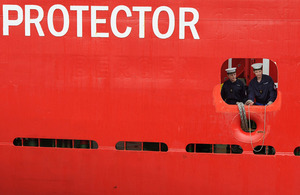HMS Protector returns from maiden deployment
Royal Navy ice patrol ship HMS Protector has returned home to Portsmouth today, 27 June, from her maiden deployment.

Members of HMS Protector's ship's company preparing to come alongside at Portsmouth [Picture: Leading Airman (Photographer) Maxine Davies, Crown Copyright/MOD 2012]
The 5,000-tonne ice-breaker spent most of her seven months away surveying and patrolling the Antarctic Peninsula.
In her first deployment since joining the Navy’s fleet in June last year, Protector conducted three separate intensive work periods in the ice. She used her multibeam echo sounder and deployed her survey motor boat to provide hi-tech hydrographic charting and imagery of the region for the UK Hydrographic Office, which provides 80 per cent of the world’s nautical charts.
The ship also assisted with the resupply of British Antarctic Survey stations in the region.
On February 23 sailors from the ship tackled a ferocious fire which raged through a Brazilian research base on King George Island in the South Shetland Islands. They fought for hours to tackle the blaze which claimed the lives of two of the base’s personnel.
Protector’s crew used the ship’s small boats to land vehicles and equipment. Operations ashore were co-ordinated by her executive officer, Commander Don Mackinnon, working with Chilean and Brazilian naval personnel.

Captain Peter Sparkes greets his wife on the gangway of HMS Protector [Picture: Leading Airman (Photographer) Maxine Davies, Crown Copyright/MOD 2012]
A few weeks later the ship punched through the ice in a race against time to pick up a team of British Antarctic Survey scientists.
Protector put the group on the remote James Ross Island but worsening weather meant they had to be rescued four days later. With a change of wind direction there was a chance ice from the Weddell Sea would be driven towards the island, potentially blocking the ship in.
Commanding Officer Captain Peter Sparkes decided the safest and least risky option would be to sail through the ever-increasing pack ice and send in the ship’s work boats and fast rescue craft to retrieve the scientists.
They were safely extracted with all equipment, and were back on board within 90 minutes of the first boat entering the water in a ‘textbook’ operation.
The deployment also included surveying the forbidding shore of Point Wild on the northern coast of Elephant Island.
On previous visits the Navy’s attempts to survey the waters have been thwarted by the elements, but Protector’s small inflatable boats were able to land personnel to collect data about the tide, shoreline and water. This will allow accurate depths to be plotted on updated charts - particularly important as the area is an increasingly popular destination for cruise ships.
In April, Protector ventured to her most southerly point of the deployment, the Rothera Research Station, 800 miles (1,300km) south of Cape Horn. The ship delivered aviation fuel in rolling seas and in temperatures of minus 15 degrees Celsius.
Captain Sparkes said:
Protector’s return from her inaugural deployment to Antarctica represents a significant achievement for the ship’s company who have transformed this unique ship into a Royal Navy warship, deployed her and operated her in the most challenging environment, and recovered her safely to the United Kingdom, all within 12 months. We now prepare ourselves to redeploy the ship south again in September.